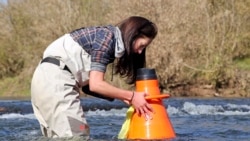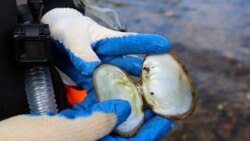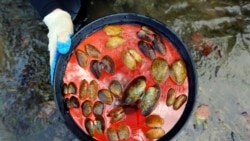Scientists are investigating a massive die-off of mussels in a major river in the southeastern United States. They hope to learn the cause.
In 2016, fish and wildlife officials discovered a big drop in the mussel population in the Clinch River. The river flows about 480 kilometers through the states of Virginia and Tennessee. It is home to many different kinds of fish and 46 species of mussels.
While freshwater mussels are small, they perform some important activities to keep rivers healthy. Mussels can clean up up to 38 liters of river water each day, removing algae, metals and other materials. The process can create a better river environment for fish, amphibians, plants and insects.
For this reason, scientists are working to find the cause of the large drop in mussel populations.
Jordan Richard is a biologist with the U.S. Fish and Wildlife Service. He told The Associated Press that officials have estimated that hundreds of thousands, possibly even millions, of mussels have died in the Clinch River.
The mass die-off in the river of one kind of mussel, called the pheasantshell, has been especially worrisome. Officials say the population of pheasantshells dropped from 94,000 in 2016 to less than 14,000 in 2019. They measured the decrease along a 200-meter stretch of the Clinch River.
Similar die-offs have been reported on at least five U.S. rivers and another in Spain. Richard has studied reports of similar die-offs over the years in rivers around the world. But so far he has not come up with many answers about why they happened.
Speaking about the Clinch, Richard said the river could even be compared to the Amazon because it contains so many different kinds of life. He spoke to the AP while examining the river’s mussel population in a rural community in Tennessee.
Mussel populations around the world have dropped sharply over the past 100 years. Scientists blame this on pollution, habitat loss and climate change. But they suspect the most recent decreases have another cause.
Richard and his team believe an infectious disease could be responsible. The team is comparing healthy pheasantshell mussels to dying ones in an attempt to narrow down a list of possible diseases.
“All living things are chock-full of microorganisms, and we don’t have any sort of map for what is healthy inside a mussel,” Richard said.
University of Wisconsin disease specialist Tony Goldberg is helping with the investigation. He specializes in wildlife illnesses of unknown cause. Goldberg told the AP that often disease is the final thing to kill a species that has already been harmed by other environmental conditions.
However, he says he is hopeful that the freshwater mussel team will be able to discover the cause of the massive die-offs and find a way to prevent them. The team includes scientists from the U.S. Geological Survey and a nonprofit conservation group.
“I see it as a race against time, not an impossible task,” Goldberg said, adding “…if we lose these mussels, the rivers we all love are never going to be the same.”
I’m Bryan Lynn.
The Associated Press reported on this story. Bryan Lynn adapted the report for VOA Learning English. Caty Weaver was the editor.
We want to hear from you. Write to us in the Comments section, and visit our Facebook page.
_________________________________________________________________
Words in This Story
species – n. a group of animals or plants that are similar and can produce young animals or plants
algae – n. a plant with no stem or leaves that grows in or near water
amphibian – n. a type of animal that can live both on land and in water
habitat – n. the natural living environment for living things
chock-full – n. very full











